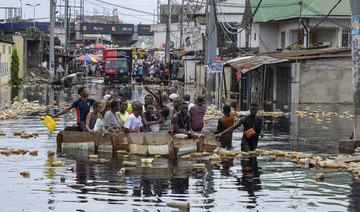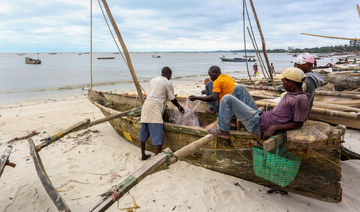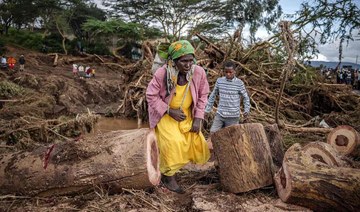NORFOLK, Virginia: With praise and a blessing for the military, President Donald Trump helped hand over the USS Gerald R. Ford to the Navy on Saturday and said the state-of-the-art aircraft carrier will send a “100,000-ton message to the world” about America’s military might when it is ultimately deployed.
US allies will rest easy, Trump said, but America’s enemies will “shake with fear” when they see the Ford cutting across the horizon.
The president, who is commander in chief of the US armed forces, likened the $12.9 billion warship to “an incredible work of art” and boasted about the American labor that went into building a vessel that eventually will house thousands of sailors and crew members.
Trump’s participation in the ceremony also capped “Made in America” week at the White House, during which the president and administration officials sought to draw attention to the US manufacturing industry.
“American steel and American hands have constructed this 100,000-ton message to the world,” Trump said of the Ford during a speech that praised the bravery and spirit of US service members and referenced his desire for a buildup after years of spending restrictions.
“American might is second to none and we’re getting bigger and better and stronger every day of my administration. That I can tell you,” Trump told thousands of service members and guests, including former defense secretaries Dick Cheney and Donald Rumsfeld, and Govs. Terry McAuliffe of Virginia and Rick Snyder of Michigan, who were packed into the steamy hangar bay on the main deck.
“Wherever this vessel cuts through the horizon, our allies will rest easy and our enemies will shake with fear because everyone will know that America is coming, and America is coming strong,” Trump said.
After the speech, he put the Ford into commission and asked God to “bless and guide this warship and all who shall sail in her.” He was followed by Susan Ford Bales, the ship’s sponsor and daughter of the 38th president, whom the ship honors.
“There is no one, absolutely no one, who would be prouder of the commissioning of this mighty ship than the president of the United States, Gerald R. Ford,” she said. “I am honored to give the command: ‘Officers and crew of the United States Gerald R. Ford, man our ship and bring her to life.’“
“Anchors Aweigh” played as row after row of sailors in crisp, white uniforms who had been standing in formation began filing off to man their stations. Sirens and bells sounded, horns blared and the US flag was hoisted high above the deck.
Soon after, the captain was informed that the “ship is manned and ready and reports for duty to the fleet.”
Trump, who visited the carrier in March, told Time magazine this year that the Navy should revert to using steam catapults to launch fighter jets because some of the USS Ford’s state-of-the-art systems and technology “costs hundreds of millions of dollars more money and it’s no good.”
Construction started in 2009 and was to be completed by September 2015 at a cost of $10.5 billion. The Navy has blamed the delays and budget overruns on the ship’s advanced systems and technology, including electromagnetic launch systems for jets and drones that will replace steam catapults.
The warship also has a smaller island that sits farther back on the ship to make it quicker to refuel, re-arm and relaunch planes, and a nuclear power plant designed to allow cruising speeds of more than 30 knots and operation for 20 years without refueling.
The vessel completed sea trials in April but still will go through a battery of tests and workups at sea before becoming ready for deployment, work that is expected to cost nearly $780 million and take more than four years to complete, congressional auditors said this month.
Docked at Naval Station Norfolk, the USS Ford eventually will house about 2,600 sailors, 600 fewer than the previous generation of aircraft carriers. The Navy says that will save more than $4 billion over the ship’s 50-year lifespan.
The air wing to support the Ford could add more personnel to the ship, which is designed to house more than 4,600 crew members.
The Ford was built at Newport News Shipbuilding, a giant Navy contractor in Virginia.
“I was with you four months ago and I knew that I had to be here today and I told you I’d be back to congratulate you and the crew and everybody involved in commissioning the newest, largest and most advanced aircraft carrier in the history of this world,” Trump said Saturday. “That’s a big achievement.”
___
Associated Press writer Steve McMillan in Richmond, Virginia, and Ben Finley in Norfolk, Virginia, contributed to this report.
Trump: USS Ford is ‘100,000-ton message to the world’
Trump: USS Ford is ‘100,000-ton message to the world’

India’s Modi skips election in Kashmir as critics dispute integration claims
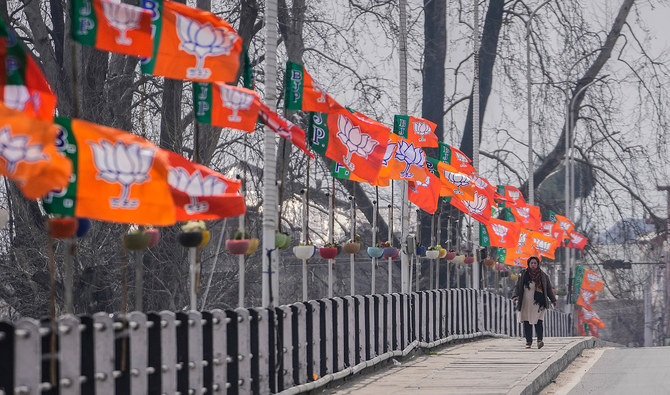
- Narendra Modi says the 2019 revocation of special constitutional status brought normalcy to Kashmir
- Critics say the BJP should have treated the election as a referendum in its favor, but it seems ‘scared’
ANANTNAG, India: Prime Minister Narendra Modi is crisscrossing India in a marathon election campaign but, for the first time since 1996, his Bharatiya Janata Party (BJP) is not contesting in Kashmir, where a 35-year uprising against Indian rule has killed tens of thousands of people.
Instead, the main contenders for the three seats in the Muslim-majority region are powerful local parties, the National Conference and the People’s Democratic Party (PDP). They will contest against each other but both say they are opposed to the Hindu nationalist BJP and will align with the Congress party-led opposition alliance.
Analysts and opposition parties say the BJP decided to skip contesting the election because the outcome is likely to contradict Modi’s narrative of a peaceful, more integrated Kashmir since he removed the region’s semi-autonomous status in 2019 and brought it under New Delhi’s control.
The BJP, along with allies, is contesting in every other part of India and is tipped to win a majority of parliament’s 543 seats on the back of its Hindu-first image.
“Why are they absent from the election?” asked Omar Abdullah, a leader of the National Conference and a former chief minister of Jammu and Kashmir state.
“Clearly there is a gap between what the BJP claims to have done and the reality on the ground,” he said, speaking in his home in Kashmir’s main city, Srinagar.
Modi says his 2019 decision brought normalcy to Kashmir after decades of bloodshed and that he will bring investments and jobs soon. The federal Home (Interior) Minister Amit Shah backs up the government’s position by claiming that youths now hold laptops in their hands instead of stones that they used to throw at security forces in the past.
As part of the move, Jammu and Kashmir state was split into two federally ruled areas — the Muslim-dominated Kashmir valley with the Hindu-dominated Jammu plains, and mountainous, Buddhist-dominated Ladakh.
The government slapped a harsh lockdown on Kashmir at the time and Abdullah and almost all other local leaders were held in custody for months.
Ravinder Raina, the chief of the Kashmir unit of the BJP, said the party’s decision to skip the election was part of a broader strategy, although he declined to give specifics.
“The BJP will not fight, but support a candidate who will work for peace, happiness, brotherhood and democracy,” in each of the three seats, he said. The BJP has not yet announced which of the many small parties in the fray it will support.
Alienation, discontent
Interviews with over a dozen residents, political leaders, security officials and analysts in Kashmir and New Delhi indicate that discontent and alienation continue to simmer in the heavily militarized Himalayan region.
Besides the three-decade insurgency, Kashmir is divided into India-controlled and Pakistan-controlled sectors and claimed in full by both nations. The nuclear-armed enemies have fought two of their three wars since independence in 1947 over Kashmir.
India claims that Islamic Pakistan has supported the insurgency in Kashmir, while Islamabad says it only provides moral support to the people there.
Abdul Hameed, a 50-year-old garment store owner in Pulwama town near Srinagar, said the federal government had kept the lid on Kashmir since 2019, masking the true situation.
“But it is like a spring. Right now they have crushed it. But who knows when will it burst open again,” he said.
Although there are fewer restrictions on people’s movements compared to five years ago, there are still tens of thousands of troops in the valley to enforce the peace.
For decades, residents and human rights groups have accused Indian security forces of atrocities against the mainly Muslim population. The government says cases of abuse are isolated acts and it prosecutes any soldier found guilty of human rights violations.
Indian military data show there are over 100 active militants in the region, who allegedly target security forces and workers from other parts of India. Militants killed an air force soldier in an attack on a military convoy on Saturday, officials said.
“The absence of an elected system over here is an indication of the fact that things are not as they are portrayed,” said Sheikh Showkat Hussain, a retired law professor, in Srinagar. “They (the BJP) should have treated (this election) as a referendum in their favor. But they seem to be scared.”
In the May 2019 general election, the BJP contested all three seats in Kashmir, losing them to Abdullah’s National Conference. This year, BJP is contesting the two seats in Jammu and one in Ladakh, all of which it had won in 2019.
Mehbooba Mufti, the chief of the PDP, is contesting from the Anantnag-Rajouri constituency, which many believed might have been the BJP’s best bet to enter Kashmir in this election.
Gerrymandering
In 2022, a federal government-appointed commission changed the borders of constituencies in Kashmir and Jammu.
To Kashmir’s Anantnag, which had around 1.6 million largely Muslim votes in 2019, it added around 1 million mostly Hindu voters from Jammu’s Poonch and Rajouri districts.
Mufti told Reuters that by clubbing them, the Modi administration was “changing the balance of the voters.” The BJP, she said, wants to “disempower and they want to divest, dispossess Muslims, especially the Kashmiris.”
National Conference’s Abdullah also claimed that the redrawing of the district was done to give BJP an “advantage.”
But they still didn’t field a candidate, which “tells you just how bad things must be for the BJP,” Abdullah said.
However, BJP’s Raina said that the redrawing has made the constituencies more representative of the region.
Floods misery reminder of climate’s role in supercharging rain
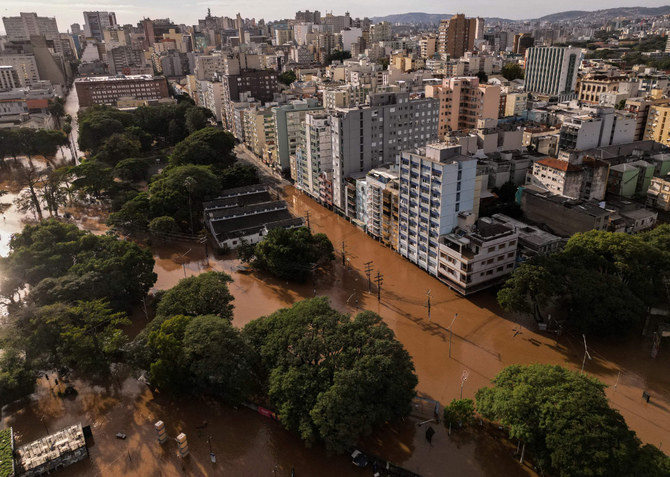
- Though not all directly attributed to global warming, they are occurring in a year of record-breaking temperatures and underscore what scientists have long warned — that climate change drives more extreme weather
PARIS: Floods have been tearing a path of destruction across the globe, hammering Kenya, submerging Dubai, and forcing hundreds of thousands of people from Russia to China, Brazil and Somalia from their homes.
Though not all directly attributed to global warming, they are occurring in a year of record-breaking temperatures and underscore what scientists have long warned — that climate change drives more extreme weather.
Climate change isn’t just about rising temperatures but the knock-on effect of all that extra heat being trapped in the atmosphere and seas.
April was the 11th consecutive month to break its own heat record, the EU climate monitor Copernicus said on Wednesday, while ocean temperatures have been off the charts for even longer.
“The recent extreme precipitation events are consistent with what is expected in an increasingly warmer climate,” Sonia Seneviratne, an expert on the UN-mandated IPCC scientific panel, told AFP.

Warmer oceans mean greater evaporation, and warmer air can hold more water vapor.
Scientists even have a calculation for this: for every one degree Celsius in temperature rise, the atmosphere can hold seven percent more moisture.
“This results in more intense rainfall events,” Davide Faranda, an expert on extreme weather at the French National Center for Scientific Research (CNRS), told AFP.
In April, Pakistan recorded double the amount of normal monthly rainfall — one province saw 437 percent more than average — while the UAE received about two years worth of rain in a single day.
This, however, doesn’t mean everywhere on Earth is getting wetter.

Richard Allan from the University of Reading said “a warmer, thirstier atmosphere is more effective at sapping moisture from one region and feeding this excess water into storms elsewhere.”
This translates into extreme rain and floods in some areas but worse heatwaves and droughts in others, the climate scientist told AFP.
Natural climate variability also influence weather and global rainfall patterns.
This includes cyclical phenomenon like El Nino, which tends to bring heat and rain extremes, and helped fuel the high temperatures seen over land and sea this past year.
While natural variability plays a role “the observed long-term global increase in heavy precipitation has been driven by human-induced climate change,” said Seneviratne.
Carlo Buontempo, a director at Copernicus, said cycles like El Nino ebb and flow but the extra heat trapped by rising greenhouse gas emissions would “keep pushing the global temperature toward new records.”
Considering the overlapping forces at play, attributing any one flood to climate change alone can be fraught, and each event must be taken on a case-by-case basis.
But scientists have developed peer-reviewed methods that allow for the quick comparison of an event today against simulations that consider a world in which global warming had not occurred.
For example, World Weather Attribution, the scientists who pioneered this approach, said the drenching of the UAE and Oman last month was “most likely” exacerbated by global warming caused by burning fossil fuels.

ClimaMeter, another rapid assessment network who use a different methodology, said major floods in China in April were “likely influenced” by global warming and El Nino.
“It can be difficult to disentangle global warming and natural variability” and some weather events are more clear-cut than others, said Flavio Pons, a climatologist who worked on the China assessment.
In the case of devastating floods in Brazil, however, ClimaMeter were able to exclude El Nino as a significant factor and name human-driven climate change as the primary culprit.
Many of the countries swamped by heavy floods at the moment — such as Burundi, Afghanistan and Somalia — rank among the poorest and least able to mobilize a response to such disasters.
But the experience in Dubai showed even wealthy states were not prepared, said Seneviratne.
“We know that a warmer climate is conducive to more severe weather extremes but we cannot predict exactly when and where these extremes will occur,” Joel Hirschi from the UK’s National Oceanography Center told AFP.
“Current levels of preparedness for weather extremes are inadequate... Preparing and investing now is cheaper than delaying action.”
Anguish as Kenya’s government demolishes houses in flood-prone areas and offers $75 in aid
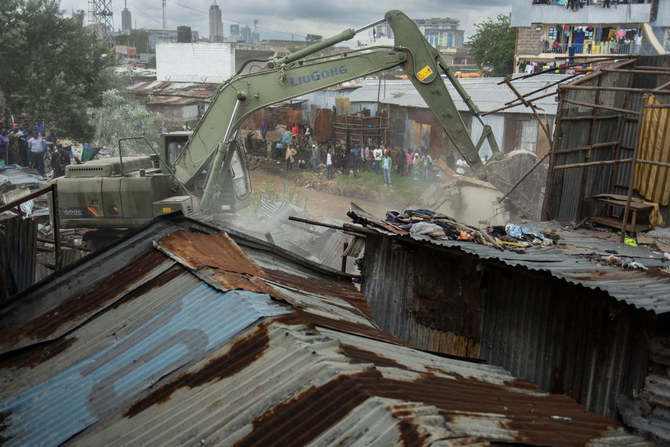
- People living near rivers, dams and other flood-prone areas told to vacate as heavy rains continue to pound
- The number of those affected by the flooding in Kenya has risen to 235,000, with most of them living in camps
NAIROBI, Kenya: Kenya’s government has begun bulldozing homes built in flood-prone areas and promising evicted families the equivalent of $75 to relocate after a deadline passed to evacuate amid deadly rains.
In the capital, Nairobi, a bulldozer ripped through iron-sheet walls as people watched in despair. Security forces with guns and batons stood guard and fired tear gas at some residents. The government last week told thousands of people living near rivers, dams and other flood-prone areas to vacate as heavy rains that have left 238 people dead in recent weeks continue to pound.
Most of those whose houses are demolished say they do not know where to go, even though the government claims they were notified about options. Human Rights Watch has accused the government of an inadequate response.
“Now what are we going to do? We love our president, and that is why we supported him. He should come to our aid,” Jekenke Jegeke told The Associated Press.
President William Ruto, who visited the vast Mathare informal settlement along the Nairobi River on Monday, said those whose houses had been demolished would be given 10,000 Kenyan shillings ($75) to help them resettle elsewhere.
Three people, including two children, have died in Mathare after being run over by bulldozers in the demolitions — one before the president’s visit and two after it — according to civil society groups.
Opposition leader Raila Odinga last week warned the government against demolishing more houses without a resettlement plan in place.
The number of those affected by the flooding in Kenya has risen to 235,000, with most of them living in camps.
Interior Minister Kithure Kindiki on Tuesday reiterated an evacuation order to 200 families living in the Kijabe area an hours’s drive from Nairobi, where about 60 people were killed and houses were swept away when water broke through a blocked railway tunnel last week.
That disaster prompted the government’s evacuation order. It is not clear how many homes across Kenya have been demolished since then.
Meanwhile, Kenya’s Cabinet has said that water levels in the country’s two major hydroelectric dams – Masinga and Kiambere – have risen to “historic levels,” with people living downstream on the Tana River told to leave.
Eastern DR Congo faces ‘catastrophe’ from floods: UN
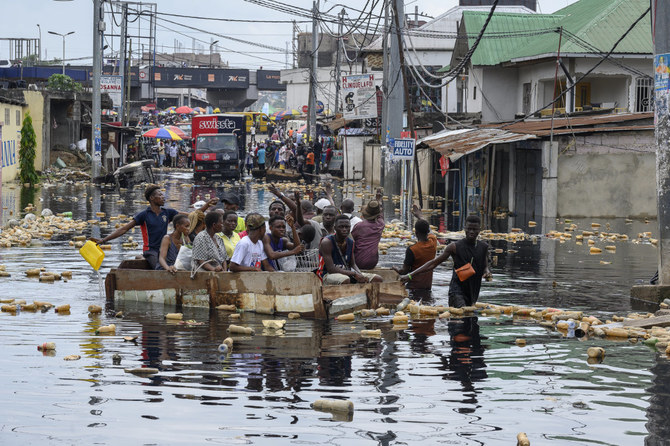
- The UN body voiced concern at the effect on health service provisions as sickness hit affected areas of the country
- Locals were reporting seeing hippos, crocodiles and snakes in flooded inhabited areas, risking fatal attacks, especially on children and livestock
KINSHASA: Eastern DR Congo faces a “humanitarian catastrophe” after being hit by severe flooding affecting about half a million people, the UN World Food Programme said Wednesday.
“Heavier rainfall than usual during the rainy season, prompted by climate change, has forced rivers and lakes to overflow, swallowing towns, villages and roads on the shores,” the WFP said in a report citing “chaos” in South Kivu and Tanganyika provinces.
Worst-affected are Haut-Lomami and Tanganyika provinces, which border the lake of the same name as well as neighboring Burundi, Tanzania and Zambia.
“All around Lake Tanganyika, and areas upstream of the Congo River basin, people have lost their homes, their fields and livelihoods,” the WFP reported, estimating 471,000 people were affected with 451,000 hectares (1.1 million acres) flooded, including 21,000 hectares of cropland.
“People in flooded areas need food, shelter, clean drinking water, health and sanitation support, as well as support to restart their livelihoods.
“However, WFP has very limited resources to respond to the flooding crisis due to current funding levels and the food assistance pipeline situation.”Democratic Republic of Congo (DRC).
“With towns and villages swallowed in the lakes and rivers, diseases are rife. Latrines have overflowed into the water that surrounds people’s homes and sanitation is poor.
“People are forced to wade through and wash their clothes and cooking implements in cholera-riddled water,” said the report, warning of “a whole host of animal-borne diseases.”
Locals were reporting seeing hippos, crocodiles and snakes in flooded inhabited areas, risking fatal attacks, especially on children and livestock.
Amid lost harvests, “people are struggling to feed their families which is leading to more people arriving in health care facilities with symptoms related to months of poor food intake. Especially children are at risk of developing malnutrition.”
Flooding has hit vast swathes of Africa in recent weeks, which have notably claimed 257 lives in Kenya, according to a latest toll Wednesday.
US House quickly defeats Republican hardliners’ effort to oust Speaker Johnson

- Democrats joined Republicans in a 359-43 vote to protect Johnson’s speakership to avoid a replay of the chaos that occurred in October
- Hakeem Jeffries, the House's Democratic Party leader, said he hoped to see House Republicans turn against party hard-liners
WASHINGTON: The US House of Representatives on Wednesday swiftly and overwhelmingly defeated an effort by firebrand Republican Marjorie Taylor Greene to remove Speaker Mike Johnson, a fellow Republican, from his leadership role.
Democrats joined Republicans in a 359-43 vote to protect Johnson’s speakership, in a bid to avoid a replay of the chaos that occurred in October when Republicans ousted his predecessor, Kevin McCarthy.
Greene’s move represented a rare Republican defiance of presidential candidate Donald Trump, who in a social media post following the House vote on Wednesday, said it was “not the time” for Republicans to try to push out their own speaker.
Greene’s measure, known as a motion to vacate, showcased the disorder that has marked Republicans’ slim 217-213 House majority, particularly since it had been clear that the effort would fail given Democrats’ opposition.
“I appreciate the show of confidence from my colleagues to defeat this misguided effort,” Johnson, 52, said following the vote. “Hopefully this is the end of the character assassination that has characterized the current Congress.”

Multiple Republicans criticized Greene’s move, including centrist Representative Marc Molinaro.
“This is not an individual who knows how to lead,” Molinaro said of Greene. “She’s not an individual who knows how to negotiate. And she certainly doesn’t seem to have any concern for the stability of the Congress or the people we represent.”
Greene stood flanked by fellow Republican Thomas Massie when she made her move against Johnson, criticizing him for a string of compromises with Democrats, who hold a majority in the Senate.
“Excuses like ‘this is just how you have to govern in divided government’ are pathetic, weak and unacceptable,” Greene said of Johnson. “Even with our razor-thin Republican majority we could have at least secured the border.”
Taunts and jeers
The chamber erupted in taunts and cheers at points as Greene read her resolution, with Democrats at times chanting “Hakeem, Hakeem,” a reference to their party leader, Hakeem Jeffries, in an echo of the many times they voted for him as speaker during Republicans’ multiple rounds of voting for speaker since the current House was seated in January 2021.
Johnson has angered many hard-liners by enacting bipartisan spending measures to avoid government shutdowns and aid US allies including Ukraine, without insisting on strict security measures for the US-Mexico border that Democrats reject.
The House Republicans’ border security bill had no chance of passing the Democratic-controlled Senate.

A bipartisan compromise bill negotiated late last year and early this year in the Senate, with the Biden administration’s approval, was killed by House and Senate Republicans at Trump’s behest.
Johnson could be seen walking around the House floor after Greene began her call on Wednesday for his ouster, with Republican supporters shaking his hand and patting him on the back.
“Republicans have to be fighting the Radical Left Democrats, and all the Damage they have done to our Country,” Trump said in his Wednesday post. “We’re not in a position of voting on a Motion to Vacate. At some point, we may very well be, but this is not the time.”
The situation has bolstered Jeffries, who agreed to save Johnson from ouster after freeing Congress from the road block of Republican infighting by delivering crucial Democratic support for must-pass bills.
Greene in remarks to reporters after the vote did not rule out trying to oust Johnson again.
For his part, Jeffries said he hoped to see House Republicans turn against party hard-liners, saying, “The only thing we ask of our House Republican colleagues is for traditional Republicans to further isolate the extreme MAGA Republican wing of the GOP, which has visited nothing but chaos and dysfunction on the American people.”




